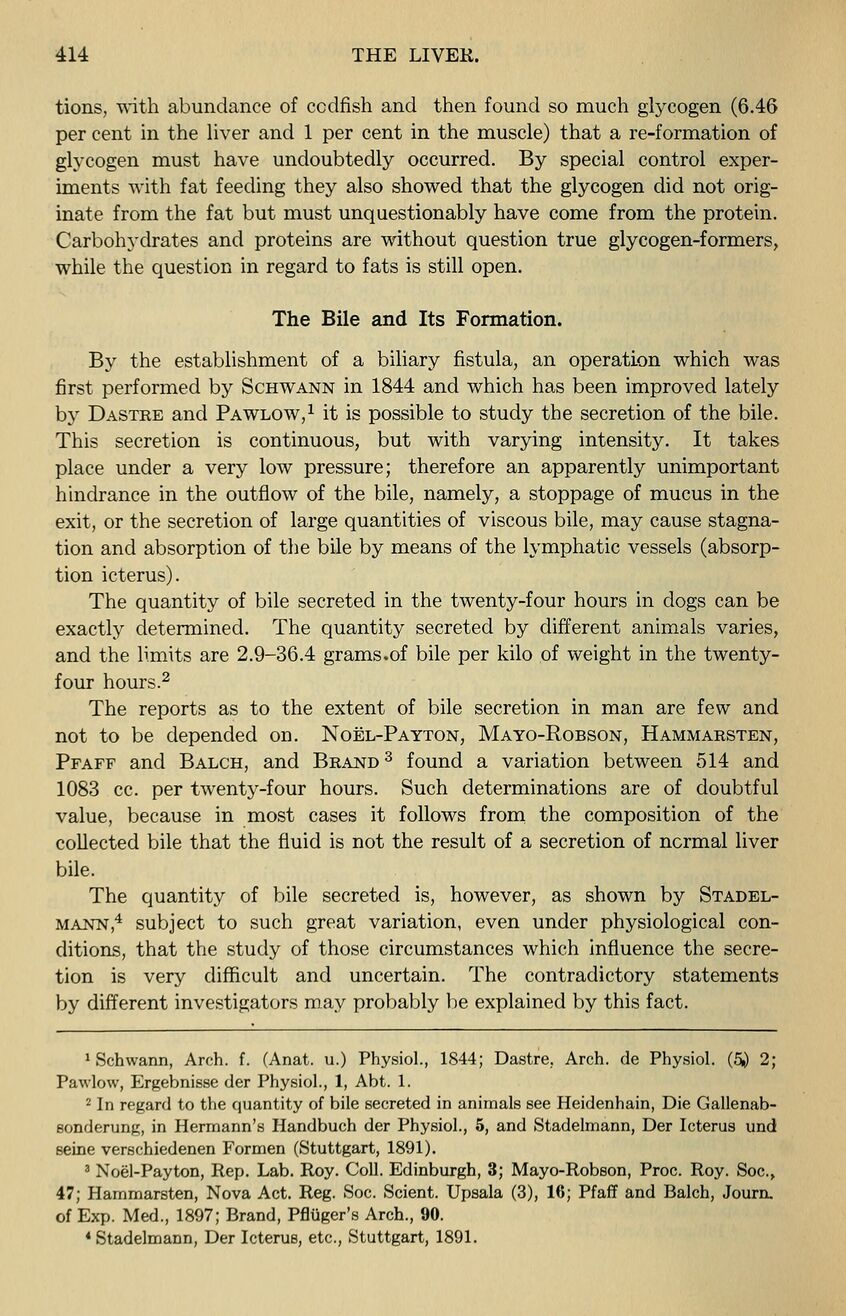
Full resolution (JPEG) - On this page / på denna sida - VII. The Liver - Glycogen and its Formation - The Bile and its Formation

<< prev. page << föreg. sida << >> nästa sida >> next page >>
Below is the raw OCR text
from the above scanned image.
Do you see an error? Proofread the page now!
Här nedan syns maskintolkade texten från faksimilbilden ovan.
Ser du något fel? Korrekturläs sidan nu!
This page has never been proofread. / Denna sida har aldrig korrekturlästs.
414 THE LIVER.
tions, with abundance of codfish and then found so much glycogen (6.46
per cent in the liver and 1 per cent in the muscle) that a re-formation of
glycogen must have undoubtedly occurred. By special control exper-
iments with fat feeding they also showed that the glycogen did not orig-
inate from the fat but must unquestionably have come from the protein.
Carbohydrates and proteins are without question true glycogen-formers,
while the question in regard to fats is still open.
The Bile and Its Formation.
By the establishment of a biliary fistula, an operation which was
first performed by Schwann in 1844 and which has been improved lately
by Dastre and Pawlow, 1
it is possible to study the secretion of the bile.
This secretion is continuous, but with varying intensity. It takes
place under a very low pressure; therefore an apparently unimportant
hindrance in the outflow of the bile, namely, a stoppage of mucus in the
exit, or the secretion of large quantities of viscous bile, may cause stagna-
tion and absorption of the bile by means of the lymphatic vessels (absorp-
tion icterus).
The quantity of bile secreted in the twenty-four hours in dogs can be
exactly determined. The quantity secreted by different animals varies,
and the limits are 2.9-36.4 grams.of bile per kilo of weight in the twenty-
four hours. 2
The reports as to the extent of bile secretion in man are few and
not to be depended on. Noel-Payton, Mayo-Robson, Hammarsten,
Pfaff and Balch, and Brand 3 found a variation between 514 and
1083 cc. per twenty-four hours. Such determinations are of doubtful
value, because in most cases it follows from the composition of the
collected bile that the fluid is not the result of a secretion of normal liver
bile.
The quantity of bile secreted is, however, as shown by Stadel-
mann,4
subject to such great variation, even under physiological con-
ditions, that the study of those circumstances which influence the secre-
tion is very difficult and uncertain. The contradictory statements
by different investigators may probably be explained by this fact.
1
Schwann, Arch. f. (Anat. u.) Physiol., 1844; Dastre. Arch, de Physiol. (5i) 2;
Pawlow, Ergebnisse der Physiol., 1, Abt. 1.
2
In regard to the quantity of bile secreted in animals see Heidenhain, Die Gallenab-
eonderung, in Hermann’s Handbuch der Physiol., 5, and Stadelmann, Der Icterus und
seine verschiedenen Formen (Stuttgart, 1891).
3
Noel-Payton, Rep. Lab. Roy. Coll. Edinburgh, 3; Mayo-Robson, Proc. Roy. Soc,
47; Hammarsten, Nova Act. Reg. Soc. Scient. Upsala (3), 16; Pfaff and Balch, Journ,
of Exp. Med., 1897; Brand, Pfluger’s Arch., 90.
4
Stadelmann, Der Icterus, etc., Stuttgart, 1891.
<< prev. page << föreg. sida << >> nästa sida >> next page >>